 The Ones that Got Away
The Ones that Got Away
Military historian Charles Herrick’s most recent contribution to this project — a precise timeline for the transit of Robert Capa’s D-Day films from the moment of his departure from the Easy Red sector of Omaha Beach to the moment of their arrival at LIFE‘s London office and deposit in the hands of assistant picture editor John Morris — illuminates an aspect of this story heretofore neglected by all concerned, this team included. As such it forces me (and others too, I hope) to rethink key aspects of the Capa D-Day myth as initially propounded by Capa and Morris and then furthered and elaborated by others.
First and foremost, it makes clear the logistical situation that Capa (and Morris) surely knew of and understood as D-Day approached, a schedule and sequence that affected and most likely determined Capa’s decisions and actions that day and the next.
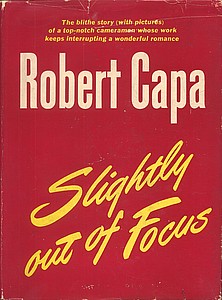
Robert Capa, “Slightly Out of Focus” (1947), cover.
I began this investigation by accepting Capa’s statement that a panic attack had caused him (understandably) to leave the Easy Red sector of Omaha Beach and return to the USS Samuel Chase on D-Day, simply concluding that this had happened much sooner than he claimed. Since then, gradually, I have come to believe that Capa made those decisions and took those actions not out of fear or cowardice but pragmatically, calculatedly, and with advance planning. Subsequently, the evidence suggests, he exaggerated and misrepresented his D-Day experiences to make himself seem more antiheroic and his account of those passages more cinematic for his book Slightly Out of Focus (1947), the “autobiographical novel” he had yet to begin writing but already planned to sell to Hollywood as a film treatment.
•
Let’s begin our review of this chain of events, as set forth in Herrick’s posts, by reiterating the blunt, inflexible fact at the far end of it, emphasized by Morris in every account he has ever given of this moment: The package of D-Day images and captions that he would send to LIFE headquarters for its D-Day issue would have to leave London via courier at 9 a.m. on the morning of Thursday, June 8, 1944 in order to reach LIFE‘s New York office by the morning of Saturday, June 10, the day on which that issue would close. Anything that did not arrive at the London office in time for processing and preparation by the night of June 7 would therefore miss that shipment, and would become immediately irrelevant; by LIFE‘s next deadline, a week later, the war would have moved on, and D-Day itself, at least for the moment, would have become old news.
Both Morris and Capa knew this. According to Morris (in his 1997 memoir Get the Picture), when sending him to London LIFE picture editor Wilson Hicks had made it clear that his future at the magazine depended on him facilitating the production of a great D-Day story, one worthy of that preeminent periodical’s reputation. Morris had no say in the coverage itself; he lacked authority to make any of the assignments, which the staffers and Capa (there as a freelance or “contract photographer”) arranged with others higher up the LIFE chain of command. Hicks simply charged Morris with gathering the materials, doing a rough edit thereof, captioning that selection, and moving it through the censorship and distribution systems so that it reached the New York office on time.
•
However, while LIFE would have exclusive rights to Capa’s images among the weekly magazines, some of his D-Day images would get distributed for publication before that. Supreme Headquarters Allied Expeditionary Forces (SHAEF), through whose Ministry of Information LIFE and its journalists, including Capa, received their accreditation for D-Day coverage, would not only censor the results but would have the option of releasing any of those images itself. As Herrick writes,
“SHAEF had created a Pictorial Selection Committee to choose significant photos for rapid radio transmission to North America via military circuits. During the pooling period, all photos from SHAEF-accredited correspondents like Capa were made available to this committee. At least one of Capa’s beach shots was transmitted to the U.S. by this method on 8 June.” [Editor’s note: Below, an example of how that image got used, credited to the Signal Corps. — A.D.C.]
Robert Capa, D-Day, front page, Ashtabula Star-Beacon, June 9, 1944
Furthermore, whatever pictures passed the SHAEF censors and got sent to LIFE by Morris had to go also, simultaneously, to the press pool — Associated Press (AP), United Press (UP), and the International News Service (INS) — for distribution to their subscribers. LIFE‘s accreditation by SHAEF mandated participation in this pool. Herrick again:
“Coming as it did from a designated press-pool photographer, Capa’s film would be freely marketed without restriction at the normal nominal commercial rates. In other words, any outlet in any allied or neutral country that wanted to use the pool photos could do so if they were willing to pay the standard fees.”
So Capa and the other photojournalists assigned to D-Day were also vying to get the first and best images of the invasion for the daily papers. As Herrick puts it, “Capa was, in a very real sense, working for SHAEF, with LIFE‘s interests temporarily being a secondary consideration.” He might have added that, in addition to SHAEF, Capa was working for the press pool.
•
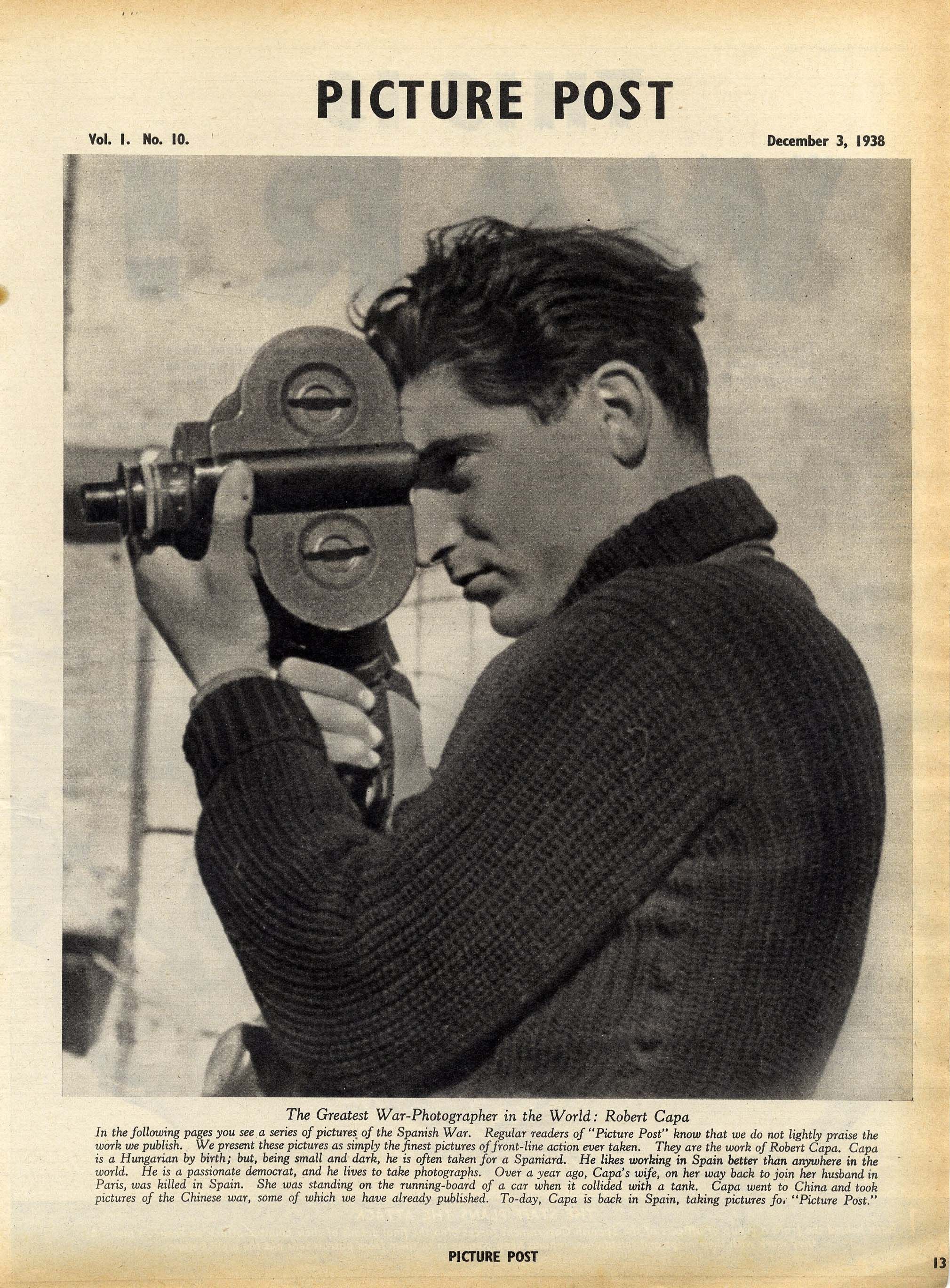
“Greatest War-Photographer in the World, Robert Capa,” Picture Post, 12-3-38
At that juncture Capa already enjoyed renown as “the greatest war-photographer in the world,” according to Tom Hopkinson of LIFE‘s British counterpart, Picture Post. LIFE wanted Capa for the D-Day feature badly enough to pay him top dollar for his coverage as a freelance, and also to give him one of the two early spots in the landing allotted to the magazine by SHAEF, effectively bumping one of LIFE‘s staffers in favor of this star. (How that sat with other LIFE photojournalists remains unclear.)
Capa was also angling for a staff position at LIFE. So, in addition to his reputation, he had that desideratum riding on his performance on D-Day. Yet he knew that, regardless of the quality and quantity of the images he made for this assignment, if that material didn’t get to Morris in London by the evening of June 7 he would have failed to fulfill this commission and his efforts would amount to naught.
•
At the time he left London for the country estate in Dorset where the military gathered the press for briefing prior to the invasion, Capa and the other journalists became effectively sequestered from the outside world, due to the top-secret nature of the invasion. From Morris’s accounts I had gathered (incorrectly, it turns out) that Capa was unable thereafter to send Morris anything — written material, films — until after he got back to England from the Normandy coast.
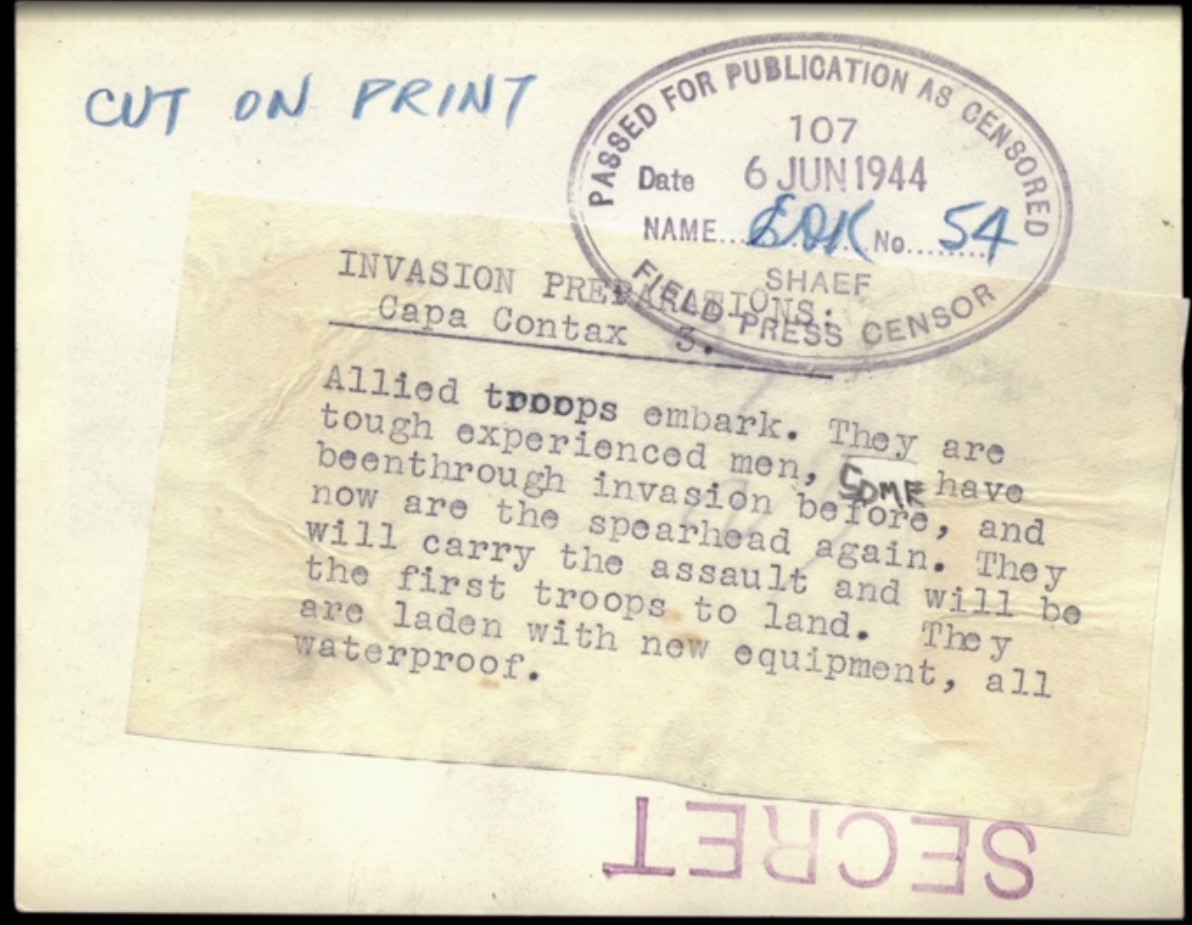
Robert Capa, untitled (troops boarding at Weymouth for D-Day), verso with caption and SHAEF stamp dated 6-6-44, screenshot from TIME video
In fact, we have found a print of a Capa image showing troops waiting at the Weymouth docks and boarding their transport craft before the convoy departed, a print approved for distribution on June 6 by the censors at SHAEF. This print carries a SHAEF-approved caption clearly derived from a known sheet of Capa’s own handwritten captions. This shows that, at the very least, Capa sent Morris one or more rolls of film with accompanying captions prior to boarding the USS Samuel Chase.
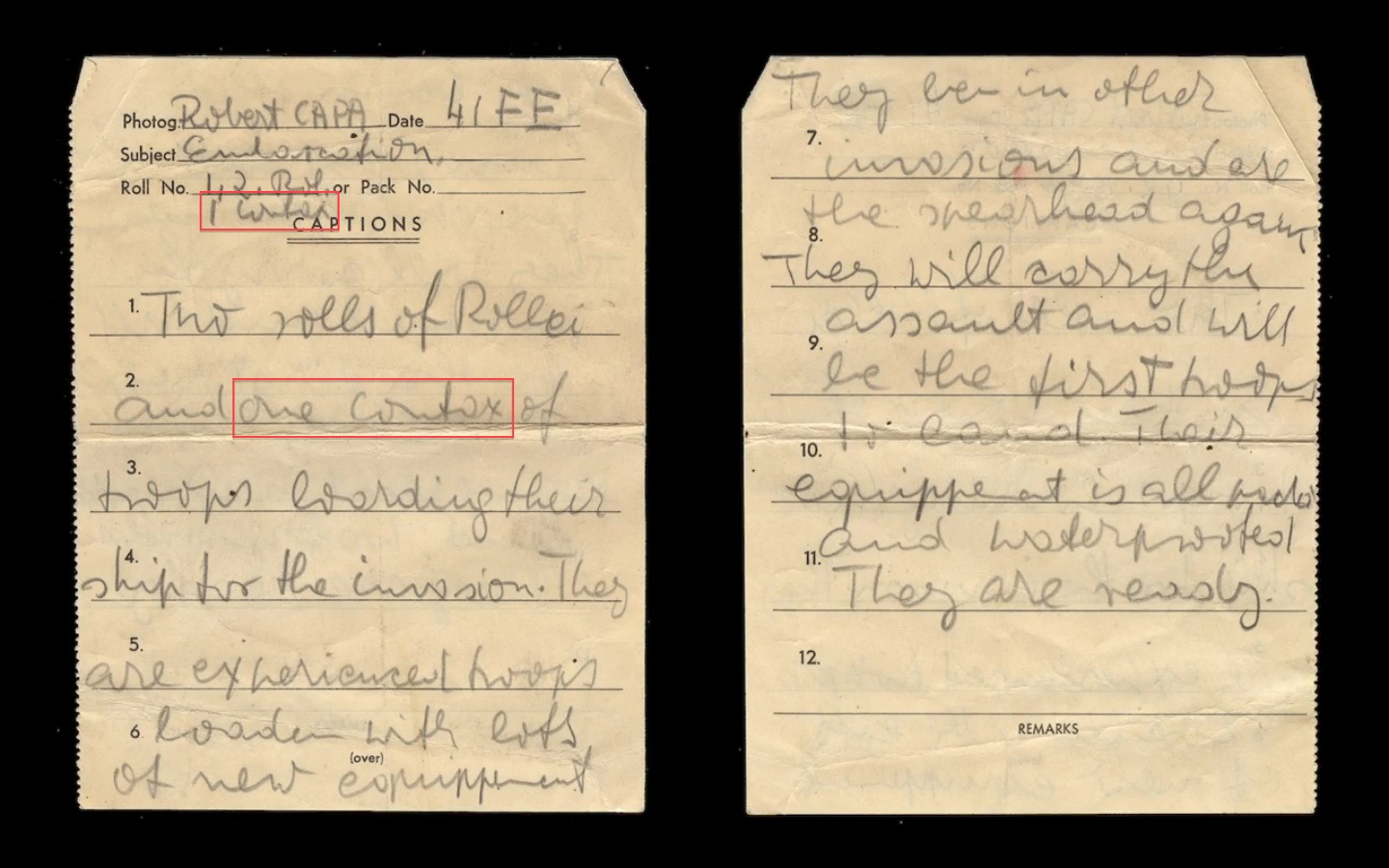
Robert Capa, D-Day image captions, Contax 35mm Roll 1, annotated.
Obviously, before the armada sailed Capa got to transmit one last batch of material destined for his editors and the press pool. Presumably other correspondents had the same opportunity, though whatever they submitted would go through the same rigorous vetting at SHAEF’s Ministry of Information that Herrick describes for subsequent images from the front.
In most of his accounts of that stretch of time, Morris claimed that he only ever got one shipment of film from Capa: everything from the Channel crossing and the D-Day images (everything made on Omaha Beach and on the return trip), plus everything made pre-D-Day. Toward the end of his life he suddenly recovered a memory of a previously unmentioned shipment, though even then he went back and forth on that, which made me skeptical of that late revision. This SHAEF-approved print, with its June 6 date, shows that such a shipment did make its way through the SHAEF censorship system, reaching Morris with the censor’s approval sometime on the 6th — probably soon after he learned that the armada had in fact sailed and the invasion had begun.
•
Both Capa and Morris knew the deadlines involved: What day of the week, and what hour of that day, the D-Day coverage had to leave London at the very latest in order to make the next issue. That timetable conformed to a familiar, established weekly routine. But neither of them — nor anyone else at LIFE, all the way up the chain of command — knew exactly when the invasion would take place. That made planning for the D-Day issue especially hard.
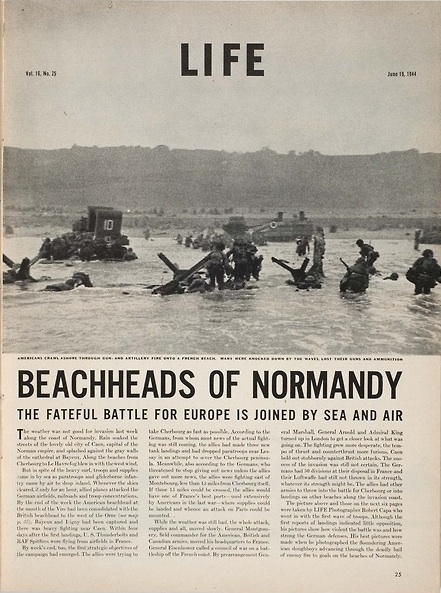
“Beachheads of Normandy,” LIFE magazine feature on D-Day with Robert Capa photos, June 19, 1944.
Had it happened when the vast armada first sallied forth, on June 4, intending to land on the morning of June 5, Capa would have had 24 hours more to amplify his coverage of the landing and still get his material to London in time to meet the looming deadline. Instead, after aborting that first effort due to weather conditions, they landed on the morning of June 6, leaving Capa precious little time to make images of the battle before heading back to the USS Samuel Chase, returning to England, and turning his films and caption notes over to a courier for delivery to the censors at SHAEF, who would determine what they would allow LIFE and other periodicals to publish.
So, using the night of June 7 as an unavoidable and fixed delivery time for Capa’s material in order to make the next issue of LIFE, Herrick has taken what some would call a back bearing, looking at the steps between that verified moment in time and Capa’s arrival via Higgins boat at Easy Red at approximately 0820 on the morning of June 6.
Capa, planning to return to England on the Chase, had left everything but his camera equipment on his bunk aboard the Chase; Ruley’s film clips show him carrying only his leather camera bag and canteen. He landed on Easy Red knowing that the schedule called for the Chase to weigh anchor and start back to England before noon, and that the trip back to the Chase — against the tide — could take several hours. Consequently, he had only a few minutes in which to make pictures before catching the next vessel heading toward the Chase. For that purpose, anything outgoing would do.
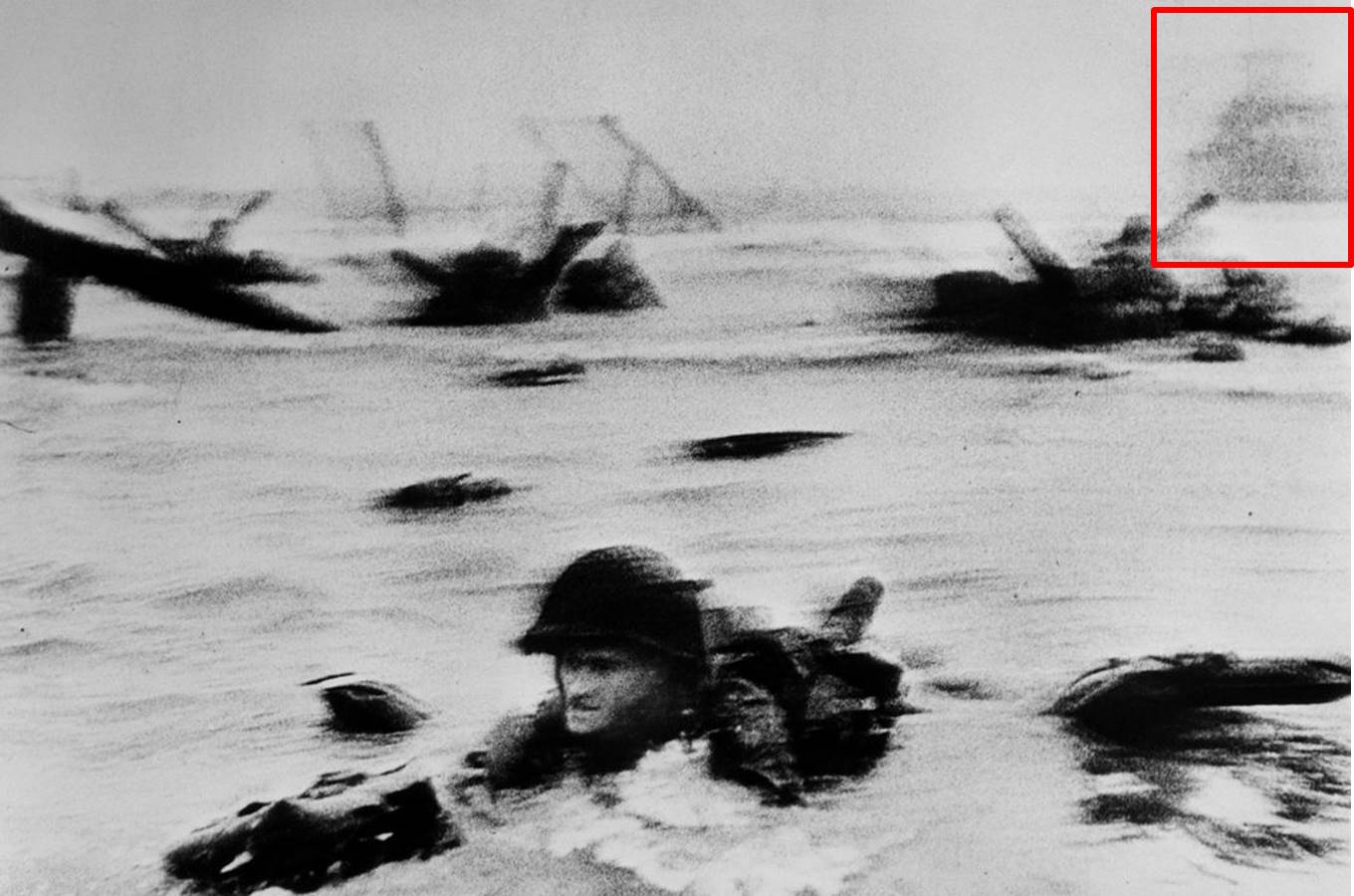
Robert Capa, “The Face in the Surf,” annotated. The outline of LCI(L)-94, on which Capa returned to the USS Samuel Chase from Omaha Beach, appears in the red rectangle on the upper right.
His best-known D-Day exposure, “The Face in the Surf,” registers the blurred outline of LCI(L)-94 in its upper right-hand corner. That’s the vessel he ran to shortly after making that picture, and rode back to the Chase, getting filmed en route by U.S. Coast Guard cinematographer David T. Ruley.
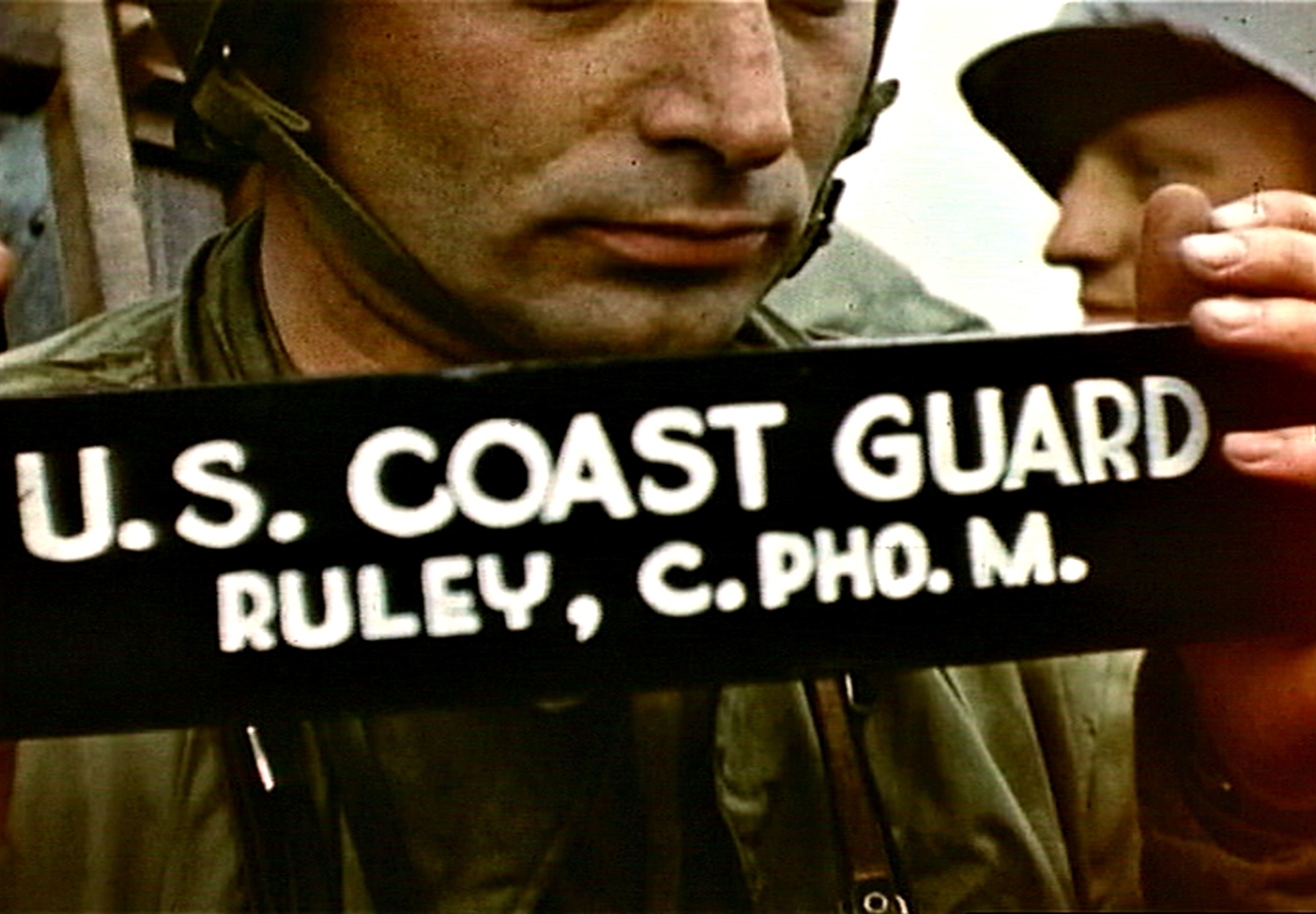
Fig. 10: Robert Capa holding cinematographer’s slate aboard LCI(L)-94, D-Day, frame from film by David T. Ruley
•
In October 2014, subsequent to my visit to the Capa Archives at the International Center of Photography, I wrote the following:
“Given the inconsequential, unrevealing content of the surviving images [made aboard the USS Samuel Chase before the landing began], which record nothing militarily sensitive, I can’t imagine that any censor would have ordered the suppression of the absent negatives, much less their destruction. The absence of any picture editor’s “print this” notches on the edges of the negatives prove that Morris did not have his darkroom staff devote time to printing any of these pre-invasion images, nor did he submit them to the SHAEF censorship system for approval on the morning of June 8 before rushing his selections for D-Day coverage to LIFE‘s NY office for publication a few days later. (Italics added.)
Clearly, I was wrong about that, on several counts. As Herrick’s account makes clear, all of Capa’s film in the packet Morris received on the night of June 7 — 35mm, 120, and 4×5 — had already gone through the SHAEF censorship process.
With Capa’s films (and David Scherman’s too) getting developed under the watchful eye of a SHAEF custody officer, no plausible possibility of a darkroom accident exists. During the development process supervised by that officer in LIFE‘s darkroom, with Morris excluded, any blank film would have been discarded. But nothing suggests that, accidentally or purposefully, Capa — a consummate professional — sent any rolls of unexposed or otherwise blank film.
So our new understanding of the SHAEF censorship process helps clarify a number of previously puzzling aspects of the narrative, unexplained elements that have lurked and nagged:
• If Capa’s ship got back to England on the morning of the 7th, why did it take so long for his films and caption notes to reach Morris? Answer: It took hours before he could disembark, and his films and captions then went to SHAEF headquarters in London to start the elaborate, time-consuming censorship process.
• Why did Capa refuse the plane ride to London he claimed the military had offered, since he could have hand-delivered his material to Morris at LIFE? Answer: His material had to go through the SHAEF system regardless; he had no authority to turn it directly over to his editor, nor did his editor have authority to accept it directly from him.
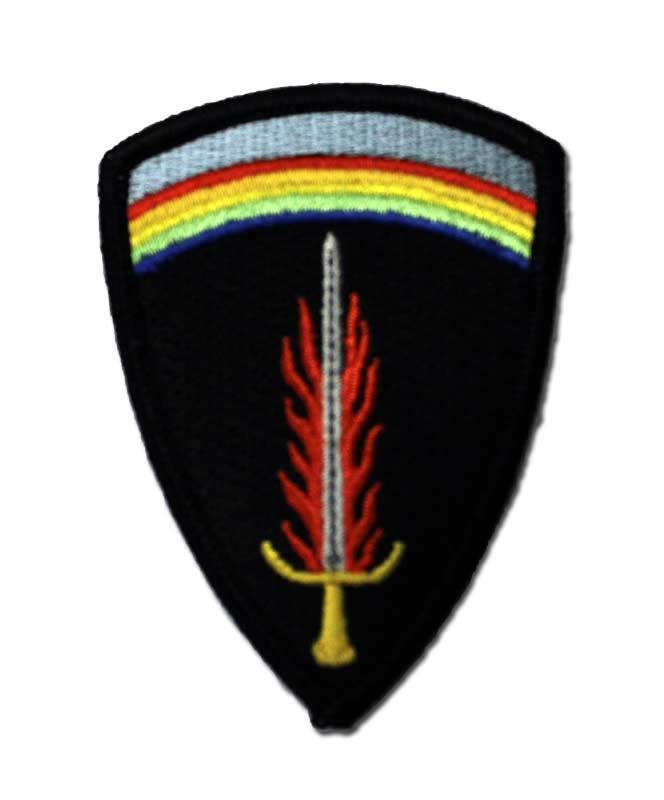
SHAEF shoulder sleeve insignia
• Could a darkroom accident explain the absence of other Capa D-Day images, including the first 28 frames of the roll that concluded with the surviving ten images made on Easy Red? Answer: My own earlier speculations anent their absence included everything from underexposure to mistakenly leaving the lens cap on. However, aside from the fact that the remaining images show no sign of damage of any sort, the fact that this roll — most likely classified top secret, along with the other films — got developed in LIFE‘s darkroom under the supervision of not just darkroom chief H. C. “Braddy” Bradshaw and LIFE staff photographer Hans Wild but also a SHAEF custody officer precludes any possibility of some fatal neglect during processing.
• What did the missing images on that roll most likely show? Answer: The first images we have from that roll show the command-headquarters team with whom Capa traveled from the USS Samuel Chase to the Easy Red sector of Omaha Beach in the 13th wave disembarking from the Higgins boat that brought them there. Assuming that Capa performed professionally that morning, starting out with fresh rolls of film in both his Contax II 35mm cameras and his Rolleiflex, the preceding images would have shown the nearby ships and landing craft of the invasion force as they made their way toward the beach.
• What is the most likely explanation for their absence? Answer: The huge size of the Normandy invasion force — which made clear that this was the full-scale invasion, not a feint — was intentionally kept secret, to persuade the German high command that the real invasion would come later, at Pas de Calais. This disinformation operation went by the codename “Fortitude South.” If Capa’s first 28 images on that roll revealed how many vessels surrounded him and his companions en route to Omaha Beach, they most probably got censored.
• Would Capa, Morris, or LIFE have any recourse in that event? Answer: All accreditation of periodicals and distribution networks (AP, etc.), as well as individual correspondents required submission to the SHAEF censorship system. The censors offered no explanations and answered to no one from the civilian sector; their word was law. Anything they withheld was simply gone — generally forever.
• Why did the SHAEF censors allow publication of Capa’s ten images of the landing on Easy Red? Answer: Clearly they had no problem with Capa’s few images of the troops on the beach. Those images show sparse U.S. troops seemingly hiding from enemy fire and struggling in the water. In no way do the images indicate or imply that the landing had succeeded. Nor do they display anything suggesting the size of the invading forces. So they do not in any way undermine the “Fortitude South” disinformation campaign. Presumably, then, the censors would have had no problem with additional photos of the troops on the beach, had Capa made more than he did. So we can dismiss the possibility that Capa did make more combat photos only to have the censors seize them. …
(Part 1 I 2)
•
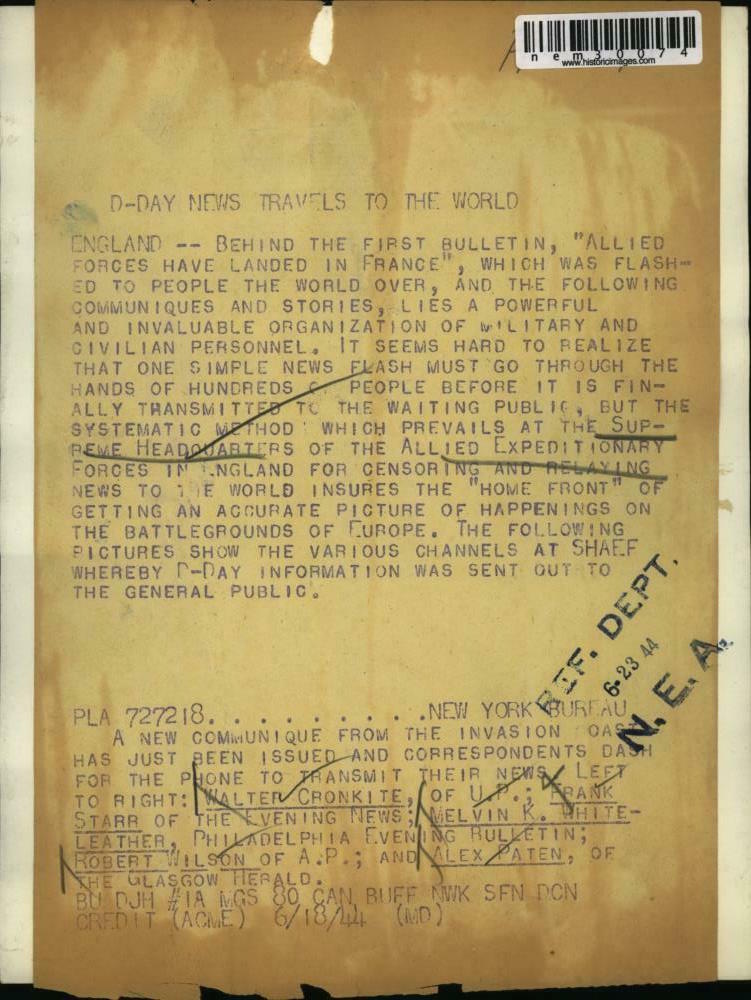
Photographer unknown, Acme Pictures, Walter Cronkite at SHAEF headquarters on D-Day, snipe on back
•
(For an index of links to all posts in this series, click here.)
•
Special offer: If you want me to either continue pursuing a particular subject or give you a break and (for one post) write on a topic — my choice — other than the current main story, make a donation of $50 via the PayPal widget below, indicating your preference in a note accompanying your donation. I’ll credit you as that new post’s sponsor, and link to a website of your choosing.
 Include a note with your snail-mail address (or email it to me separately) and I’ll include three (3!) copies of The Silent Strength of Liu Xia, the catalog of the 2012-13 touring exhibition of photos by the dissident Chinese photographer, artist, and poet, who, after eight years of extralegal house arrest in Beijing, finally got released and expatriated to Germany in 2018. The first-ever publication of her photographic work, it includes all 26 images in the exhibition, plus another 14 from the same series, along with essays by Guy Sorman, Andrew Nathan, and Cui Weiping, professor at the Beijing Film Academy. Keep one for yourself, share the others with friends.
Include a note with your snail-mail address (or email it to me separately) and I’ll include three (3!) copies of The Silent Strength of Liu Xia, the catalog of the 2012-13 touring exhibition of photos by the dissident Chinese photographer, artist, and poet, who, after eight years of extralegal house arrest in Beijing, finally got released and expatriated to Germany in 2018. The first-ever publication of her photographic work, it includes all 26 images in the exhibition, plus another 14 from the same series, along with essays by Guy Sorman, Andrew Nathan, and Cui Weiping, professor at the Beijing Film Academy. Keep one for yourself, share the others with friends.






I have to admit that I am a little confused here. My impression was that formerly you had established a timeline for Capa’s presence in Normandy that more or less precluded him shooting a large number of frames.
Now it appears that you’re willing to allow him a larger number of shots (an unknown number, I guess?) and attribute the small number of frames submitted to LIFE as the result of censorship?
Are you following up to try to get a sense of what kind of ratios of submitted/censored the other photographers on the beach experienced? This seems to be a vital bit of context, now. It’s not particularly factual, but I think that I, at least, would benefit from a better understanding of what “typical” looks like.
And this is, I think, important. Is Capa’s output “typical” or not?
Nothing in the timeline we have established and for which we have developed evidence has changed, in either Charles Herrick’s estimation or mine. He and I agree: Capa arrived on Easy Red with the 13th wave, circa 0820, photographed for about 15-20 minutes, made his way to LCI(L)-94, and left on that vessel around 0900.
What I wrote, precisely:
“[Capa’s ten known 35mm frames from Omaha Beach] do not in any way undermine the “Fortitude South” disinformation campaign. Presumably, then, the censors would have had no problem with additional photos of the troops on the beach, had Capa made more than he did. So we can dismiss the possibility that Capa did make more combat photos only to have the censors seize them.” (Italics added.)
Contrary to your reading, then, I reject any imagined scenario that would have the censors impounding additional images of the scene as Capa found it on Easy Red at that moment, since such images would merely have shown more of the same, which demonstrably they found acceptable. As I have argued from the beginning, the ten we have are all he made.
Concerning the larger questions you ask, I don’t think that anything resembling a standard “ratio” of censored to uncensored images exists, vis-a-vis Capa specifically or accredited combat photographers generally.
For example, they apparently excised 28 of 38 exposures from that particular roll — roughly 75 percent.
Looking at the remaining reconstructed 35mm contact sheets in the Capa Archive at ICP, it appears that an average of 50-60 percent are missing and presumably censored. That statistic applies also to the 10-pack of 4×5 film that I believe Capa schnorred and exposed with a borrowed Speed Graphic as officers studied the relief maps in the gym of the Chase: Only five of those appear in the archive, while I assume he exposed the whole pack instead of wasting 5 potential shots.
It’s impossible to determine the average with his 120 rolls, because no frame numbers appear on those negatives, so we can’t reconstruct the rolls and pinpoint the gaps. Sketches I made of the contact sheets showing those images indicate 10 describing the boarding in Weymouth and 5 of that same briefing in the gym (the only episode he covered in 35mm, 120, and 4×5 formats). Did those represent two 120 rolls, or are they all that remain from a larger number thereof?
According to those same sketches, the archive has four 120 exposures made on LCI(L)-94 leaving Omaha Beach and back on board the Chase. I assume Capa made at least one full roll of 120-format exposures while returning to the Chase, and at least one more on the return trip to England; if so, most of those have vanished, probably left on the cutting-room floor.
I don’t see any way that we could determine how this compared to the treatment of material submitted to SHAEF by other photographers. And of course what got cut would depend on what they photographed, what the pictures showed, and how sensitive the censors considered that data to be in re “Fortitude South” and other issues. All of which we’ll never know, since the retained pictures have long since disappeared. (Perhaps they’re warehoused at Area 51.)
Thanks, A.D. I apologize for my carelessly light read.
Accepted. Always happy to clarify.
On the larger issue of what would get censored and what wouldn’t, there were ground rules that publishers, picture editors, and photojournalists would know about. For example, in the early years of WWII it was understood that you didn’t publish pictures of dead American soldiers, on the assumption that such images would undermine morale among the troops and on the home front. So photographers likely would not have made such photos; if they did, the censors would almost certainly have held them back, so why bother? Eventually that policy changed, and so did the practice of combat photographers and picture editors and publishers.
But there were also matters of military security: advanced weaponry, the size of a particular force, marks on equipment and insignias on uniforms that identified particular divisions, landmarks that identified locations. Keeping these out of photographs as one made them would have proved impossible, and it would also have jeopardized security to issue lists of the things that the military wanted photographers to avoid. So the burden of eliminating those frames or indicating what needed to get opaqued within them fell on the censors.
Finally, there were disinformation campaigns like “Fortitude South,” for which the entire press corps had to remain in the dark due to their top-secret status. None of the photographers who covered D-Day could know that any exposures they made of the armada that suggested its vast size would get confiscated by SHAEF. Who knows how many frames, and how many rolls, and by which photographers, the censors held back during those days?